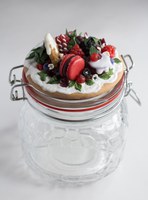Prairie Fare: Gift-giving season includes gift drawing for readers
(Click an image below to view a high-resolution image that can be downloaded)
“I think it’s time to leave,” I said to my husband.
My husband picked up our kid, who could transform into a marble statue or a column of wiggly jelly.
At this moment, our kid was a screaming two-by-four tucked under my husband’s arm enroute to the car.
This was a little embarrassing.
We had been looking at the toy section. Our child wanted a particular toy right then.
Eventually, our child learned that the “screaming statue” tactic resulted in our leaving the store immediately.
Now that our kids are in their 20s, selecting gifts isn’t as easy as a trip to the toy store. Gift cards seem to be a logical choice that allow people to choose what they want. Sometimes, however, gift cards get tucked in a drawer and are found much later, if ever.
According to a Credit Summit survey of 1,200 consumers, half of consumers lose their gift cards.
An estimated $21 billion is tied up in unused gift cards.
While gift cards are appreciated by many, what are some other gifts for adults? If you give gifts for the holidays, consider a few ideas and free online resources from NDSU Extension.
1. Give a gift that promotes safe food preparation. A food thermometer, an apron and a set of potholders are usually welcome additions to a kitchen. Grilling enthusiasts might enjoy long-handled food turners. If you like to sew, you can make the potholders and apron in the favorite colors and design of the recipient.
See www.ag.ndsu.edu/food and check out the “Home Food Safety” section for handouts about thermometers, food storage and more. They are free to download and share.
2. Create a cookbook of favorite family recipes. If you have the actual recipes in the handwriting of a relative, photocopy or scan them to make an extra-special keepsake. Add some digital photos of the recipe writer.
- Although great-grandma’s home food preservation recipes might be tempting to share, we caution against sharing “old” food preservation recipes. Cookie and cake recipes usually are fine to share, but food preservation research has led to changes in our recommendations.
- Be sure to compare “old” canning recipes to current ones. Sometimes, canning recipes withstand the test of time, but often they do not. See ag.ndsu.edu/food and go to “Food Preservation” for the latest information.
3. Consider a gift that helps you avoid food waste. We all have experienced increased prices at grocery stores. Unfortunately, an estimated 31% of food is wasted at the retail level or at home according to the U.S. Department of Agriculture’s Economic Research Service.
Let’s work together to avoid throwing away edible food. How about a new set of microwaveable bowls, freezer containers and/or an insulated lunch bag to make use of these “planned-over” foods? Consider composting leftover food scraps, such as potato peelings.
- See the “Food Preparation” section at ag.ndsu.edu/food. The “Pinchin’ Pennies in the Kitchen” series of publications have ideas to make foods from what you have on hand. These can be printed into a booklet of ideas.
- See “How to Compost” at ndsu.edu/agriculture/extension/publications/how-compost if you want to learn how to turn vegetable table scraps into “black gold” for growing gardens.
4. I have a potential gift as a thank you for reading “Prairie Fare.” We created 2024 recipe calendars. I’d like your feedback and invite you to enter a drawing for 50 free calendars (one per person) by Dec. 23.
Go to https://forms.gle/L1R5qUbthp4SQEE99 and enter the two-minute survey. If the survey link does not work for you, please send an email to julie.garden-robinson@ndsu.edu and include your name, full mailing address and an idea for a column topic. Be sure the subject of your email says “calendar drawing.”
How about some beverage, soup or bread mixes as gifts for family and friends? We have several “quick mixes” (at ndsu.ag/quick-mixes), which can be made as a recipe or layered in a jar for a gift mix.
Herb Quick Bread
2 cups all-purpose white flour
1 cup whole-wheat flour
1 tablespoon baking powder
3 teaspoons caraway seeds
½ teaspoon salt
½ teaspoon ground nutmeg
½ teaspoon dried thyme
If making a gift mix, layer the recipe ingredients in a clean quart-sized jar. Cover the jar tightly with a lid, decorate if desired and attach a copy of the recipe card.
1 recipe/jar Herb Quick Bread mix
1 egg
1 cup fat-free milk
1/3 cup canola oil
Preheat oven to 350 degrees. In a mixing bowl, whisk together dry ingredients. In a separate bowl, whisk the egg, milk and oil. Add the wet ingredients to dry ingredients and stir until moistened. Place mixture in a 9- by 5-inch loaf pan coated with nonstick cooking spray and bake for 40 to 50 minutes. Cool for 10 minutes in pan; remove from pan and place on a wire cooling rack.
Makes 16 servings. Each serving has 140 calories, 5 grams (g) fat, 4 g protein, 21 g carbohydrate, 1 g fiber and 180 milligrams sodium.
(Julie Garden-Robinson, Ph.D., R.D., L.R.D., is a North Dakota State University Extension food and nutrition specialist and professor in the Department of Health, Nutrition and Exercise Sciences.)
NDSU Agriculture Communication – Nov. 22, 2023
Source: Julie Garden-Robinson, 701-231-7187, julie.garden-robinson@ndsu.edu
Editor: Elizabeth Cronin, 701-231-7881, elizabeth.cronin@ndsu.edu




